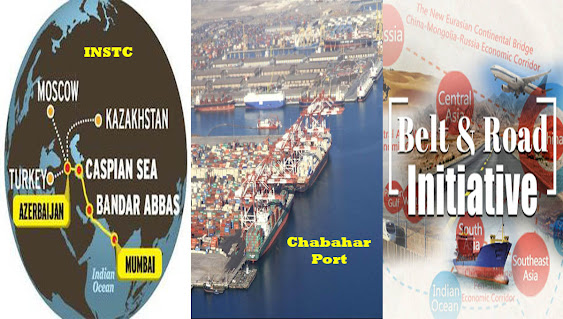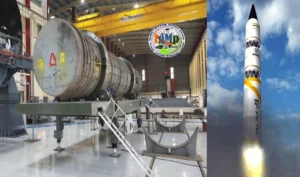Source : Asian News International (ANI)
Bishkek: An International Conference titled “INSTC (International North South Transport Corridor) and Chabahar Port in Iran: An alternative to BRI” was held on Friday at Ala-Too University in Kyrgyzstan’s capital city Bishkek.
The conference was jointly organized by the Ala-Too University, Bishkek, and a think tank Burana Institute, Bishkek.
The conference was jointly inaugurated by Dr Zhydyzbek Zhakshylykov, Head of Science and Innovation Department, Ministry of Education, Kyrgyz Republic, and Dr Sanzharbek Erdolatov, Rector, Ala-Too University, Bishkek, the think tank informed in a release.
Eminent scholars from Russia, Iran, Kazakhstan, Uzbekistan, Armenia, Poland, Sweden, England, India, and Kyrgyzstan presented papers highlighting the importance and advantages of INSTC and Chabahar port for land-locked Central Asian, CIS countries and Russia.
Professor Ali Omidi from the University of Isfahan, Iran while speaking at the conference, spoke on Iran’s role in strengthening Eurasian cooperation through the corridor. He also quoted the phrase “If you want to become Powerful, First Make a Road.”
While talking about the geopolitical importance of INSTC and Chabahar Port for India, the author said “The INSTC and Chabahar-Central Asia Corridors are of strategic importance for India, as they facilitate trade with Russia, Europe, as well as Afghanistan and Central Asia, bypassing its regional rival, Pakistan.”
“But the main goal of New Delhi through the North-South Corridor and Chabahar-Central Asia is to increase its geopolitical influence in the resource-rich republics of Central Asia, which India considers as a source of energy supply and a large market for Indian goods,” he said.
“Chabahar port for India will reduce the transportation costs by 60% and the time of transporting goods to Central Asia by 50%. India’s first export shipment from Chabahar was destined to Afghanistan in 2017 in the form of a 130,000-ton wheat shipment,” he said as per the think tank.
Emphasizing Iran’s geographical location, he called Iran’s position as strategic by saying “Iran’s position in the INSTC and Chabahar-Central Asia is strategic because of its geographical location that connects the Persian Gulf to Afghanistan and Eurasia.”
“Of course, Iran does not see itself as the stage of geopolitical rivalry between regional and global powers and welcomes infrastructure investments from different countries,” he said.
Professor Sos Khachikyan from the Armenian State University of Economics during her presentation focussed on India-Iran relations within the INSTC-Armenia context.
She spoke in detail about the INSTC project from the Armenian perspective, which is a thought-provoking one. In his speech, he said that India and Iran have the potential, as well as the necessity to be involved in worldwide transnational projects because of the following two factors: –
“Firstly, India is one of the emerging countries of the world with significant technological achievements and an increasing role in the Pacific region. Secondly, Iran proved the ability to provide technological development under the sanctions and to have a decisive role in regional stability,” she said.
“India and Iran, as emerging Asian countries with strong traditions of trade, don’t have direct lines between each other within Eurasian corridors,” she added.
She also said that Armenia could play a significant role to offer an alternative corridor to connect India and Iran with Europe through Georgia and the Black Sea.
“Armenia is the only country that signed the Comprehensive and Enhanced Partnership Agreement (CEPA) with the European Union, as well as is membership to the Russian-led Eurasian Economic Union (EEU),” she said.
Dr Shatlyk Amanov, Suleyman Demirel University, Almaty, Kazakhstan gave a presentation on “India’s Eurasian ambitions and the INSTC: Insights from the ‘South-South Cooperation 3.0’ model”.
Dr Amanov said India’s Eurasian ambitions are based on the “Connect Central Asia Policy”. INSTC was agreed upon in 2000 and ratified in 2002 by India, Iran, and Russia, and trial runs were conducted in 2016.
“The INSTC is a burgeoning multimodal connectivity project designed to link India to Iran and, through the Caspian basin, to Russia and reaching further to the North. Since its announcement, the project has been accompanied by active scholarly debate over its viability, relevancy, and scope,” he said.
Dr Amanov quoted “India is building its position as a leader in South-South cooperation, much like it played a key role in the Non-Aligned Movement. South-South cooperation has traditionally been an important pillar of India’s foreign policy and diplomacy.” (OECD, 2012).
Dr Rajkumar Sharma, Post-Doc Fellow, Delhi School of Transnational Affairs, University of Delhi gave a presentation (via video conference) on “India has the geographical and economic potential to bring together Eurasia and Indo-Pacific via INSTC”.
During his speech, Dr Sharma said that there has been big power jostling in Eurasia for connectivity as the US, Russia, China, European Union, and India have been making efforts to achieve their respective connectivity visions in the region.
“India, by the virtue of its geographical location, is a continental (Eurasian) and maritime (Indo-Pacific) power. India has the geographical and economic potential to bring together Eurasia and Indo-Pacific via INSTC,” Sharma said.
“The proposed INSTC plan is 40% shorter and 30% cheaper than the BRI – an enticing economic opportunity for India. The impact of INSTC could potentially decrease Afghanistan’s economic dependency on Pakistan. Chabahar route is 800km shorter than the Karachi port route,” Sharma added.
Rouslan Jalil, Lecturer at the OSCE Academy, Bishkek, and co-founder and Director of the Burana Institute, a Bishkek-based think-tank concluded the session by speaking on the “Concept of Democracy is not alien to India”
“INSTC might serve as a soft power tool for establishing India’s economic and political influence. However, China promoted BRI is shaped by Chinese political ideology, and one cannot have any expectations of movement of democratic ideas, concepts or practices along the BRI route,” Jalil said.
“A concept of democracy is not alien to India and whether India will also export such concepts along this route to Central Asia and further?” he asked while concluding the session, the think tank stated.





